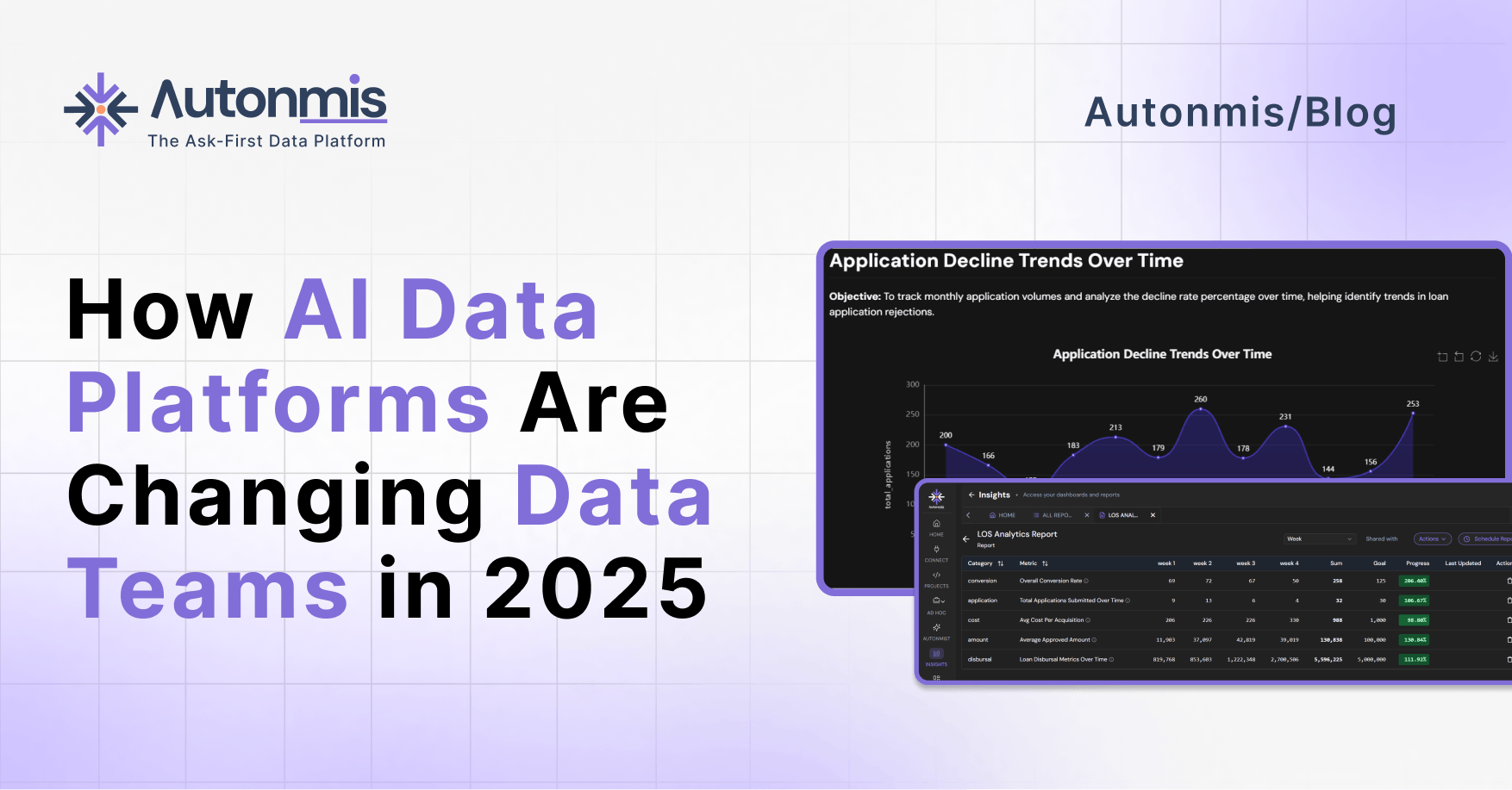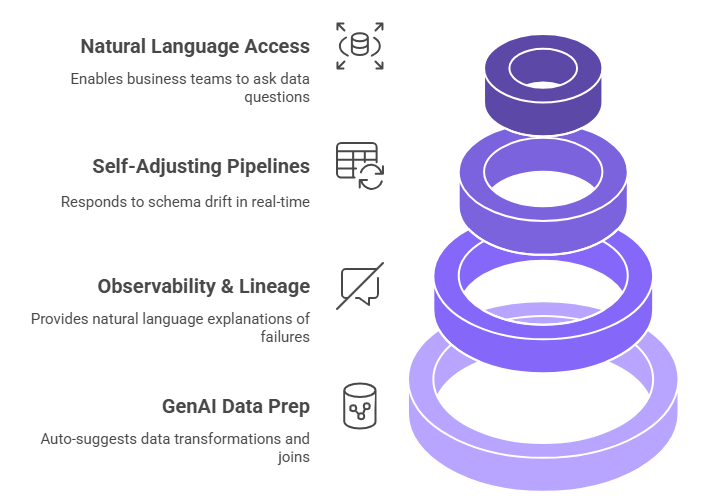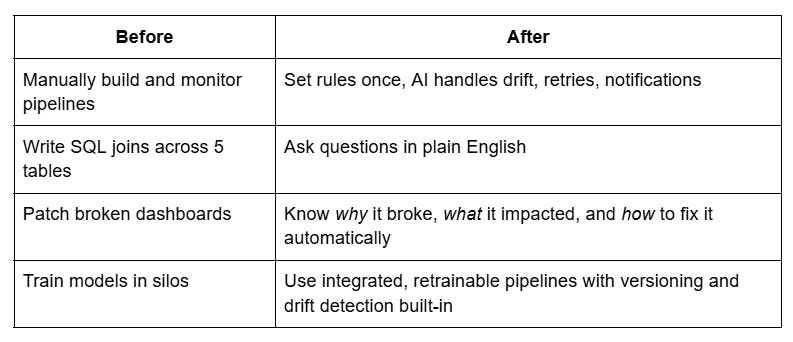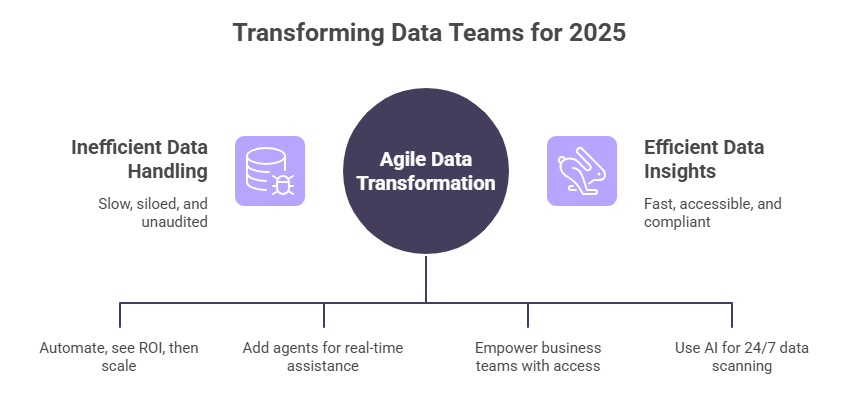1/20/2025

AB
How AI Data Platforms Are Changing Data Teams in 2025
AI-powered data platforms are reshaping how data teams work in 2025 - automating pipelines, detecting schema drift, and enabling natural language queries to boost speed and focus. If you’re still debugging broken ETL jobs, you’re already behind.

In 2025, data teams aren’t just doing things faster - they’re doing them differently.
Not because they’ve hired more people. Not because they’ve bought more dashboards. But because the platforms they work on - the ones that ingest, clean, govern, and activate data - have finally gotten smarter.
The shift didn’t happen overnight. But it’s here now. And it’s real.
AI Data Platforms Are Changing Data Teams in ways that go far beyond “automation.” They’re helping teams focus, move faster, and build infrastructure that runs itself.
Let’s break it down.
The Old Way Was Painful and Manual
If you’ve worked in data over the last few years, this might feel familiar:
- You write brittle ETL pipelines
- You debug Airflow jobs that fail silently
- You track down schema changes at 10 PM
- You get pinged about a broken dashboard before the CEO meeting
- You spend 40% of your week getting data ready to use
The biggest problem wasn’t tooling. It was the cognitive load - the glue between systems.
Checkout: What is an AI Data Platform and How Does It Work?
What’s Changing in 2025
AI powered Data Platforms introduce one major unlock: intelligence across the entire stack.
Instead of using fragmented tools (one for ingestion, another for modeling, another for observability), you now get a unified experience with smart defaults, embedded agents, and automatic governance.
Here’s how things look now:
1. GenAI-assisted data prep
The platform auto-suggests joins, deduplication rules, type inference, and even transformations - before you write a line of SQL.
2. Built-in observability + semantic lineage
You don’t just know that something failed - you get a natural language explanation of what failed, why, and what’s downstream.
3. Streaming pipelines that self-adjust
Real-time jobs now respond to schema drift and system load in real time - without paging an engineer.
4. Natural language access for business teams
Want an LTV analysis on mobile users in the last 30 days? Just ask. No JIRA tickets required.

Why This Matters: Focus, Speed, Leverage
The best part about changing data teams with AI Data Platforms isn’t just speed - it’s leverage.

What used to take 10 people can now be managed by 3 - without losing quality. In fact, the quality improves because humans are doing less grunt work and more thinking.
Rare Insight: Semantic Schema Drift Detection
Most platforms check for schema drift like this:
“If column name changes, fail the pipeline.”
The best platforms go deeper.
They embed schema names in vector space and detect when user_id becomes uid or customer_id becomes customerIdentifier. That’s semantic schema drift. It lets your pipelines keep running - even when the column names change - because the platform understands what the data means.
Most teams don’t even know this exists yet. But it’ll be standard in 12 months.
Checkout: How to Automate ETL Failures Using an AI Data Platform
Code Example: Auto-Lineage in 5 Lines
No extra YAML. No config files. Just lineage, out of the box.
What the Fastest Teams Are Doing Right Now
Here’s how we’ve seen smart teams approach Changing Data Teams in 2025:
- Start small, move fast
They automate one workflow (like lineage or PII detection), see ROI, then scale across the org. - Build internal copilots
They add Slack agents or command-line tools that explain pipeline failures, recommend joins, and write docs on the fly. - Shift from gatekeeping to enablement
They don’t just centralize data - they enable business teams to access insights independently. - Enforce policy continuously
Instead of annual audits, they use AI agents to scan data use 24/7 and alert when something's off.

Checkout: How Agentic AI Powers Autonomous Data Workspace 2025
Final Thoughts
AI Data Platforms Are changing data teams, but not by replacing people. They’re shifting the balance - from toil to strategy.
They remove bottlenecks. They reduce burnout. They make high-leverage work possible.
If you’re still stitching together legacy ETL and relying on dashboards that break every week - you’re already behind.
The teams winning in 2025 are the ones who embraced AI-powered Data Platforms early. Everyone else is playing catch-up.
Ready to see how Autonmis fits into your workflow?
We built it for this future: AI-native, composable, explainable, and fast.
→ Build data infra that works with you, not against you.
Explore Autonmis
Recommended Learning Articles

10/23/2025
Top 6 Ways AI Is Transforming Business Operations

9/22/2025

AB
The Hidden Cost of Manual Operations in BFSI
Actionable Operational Excellence
Autonmis helps modern teams own their entire operations and data workflow — fast, simple, and cost-effective.